“AI could prove incredibly useful, from configuring our kits to generating the sounds in our head”: Where might electronic drums go next? Here are 9 of our predictions

Electronic drum sets have changed the way drummers learn to play and practice - in many cases, owning an e-kit, regardless of your budget, can be the difference between becoming a drummer or not thanks to their noise-busting and space-saving abilities. They’ve come a long way, too. It wasn’t that long ago that electronic kits featured carpal tunnel-inducing, rock-hard playing surfaces with unrealistic pad shapes and form factors that felt about as realistic as hitting a tabletop. The sounds matched the playing experience, with early examples limited by technology to produce synthesised, drum machine-style sounds rather than acoustic drum recreation.
But, with incremental improvements happening every year, electronic drums have shifted focus since the ’80s from a near-novelty sound effect, to a much more authentic, acoustic drum kit substitute. Sampling and memory technology has become exponentially more efficient and effective. We now have tune-able playing surfaces which are not only round, but often similar (or at least approaching) that of our acoustic kits. Electronic drum manufacturers are now able to produce a cohesive solution to allow us to enjoy time at our kits without upsetting those around us, while also developing and applying traditional playing techniques. What was once alien and shunned by drum teachers and purists is now commonplace.
But, we’re not there yet. If you’ve ever glanced at your keyboard or guitar-playing friends through green-hued goggles as they conjure rich, natural-sounding grand pianos or a carbon copy of vintage amps and pedals from their gear, you’ll know that there are yet still improvements to be made to bring electronic drums even closer to our acoustic kits. We’re nearly a quarter of the way through the century, which seems a good time to take stock of where electronic drums are currently, what we hope will come next, and what we can realistically expect in the years ahead. Join us as we locate our Flux Capacitor, set the metronome to 88 and glimpse into the near future of electronic drums.
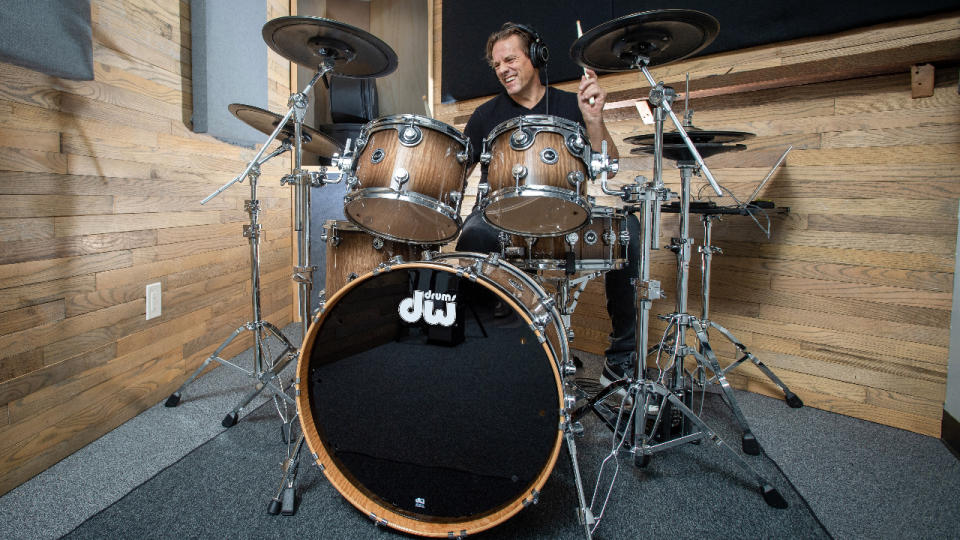
1. Blurred lines
Just as we’re seeing an erosion of the divide between ‘electronic’ and ‘acoustic’ drummers, with many players now opting for ‘electronic at home, acoustic kit on the gig’, so we’re seeing a breakdown of who makes what.
Of course, Yamaha has been at the forefront of acoustic and electronic drum kit manufacture for decades. Similarly, Pearl has had a foot in both camps for decades. In 2022, Roland, one of the leading brands in electronic instruments altogether - whose contribution to electronic drums has been a key driving force in the area’s development - announced that it had acquired DW (Drum Workshop), along with its family of brands (PDP Drums and Percussion, Slingerland and LP Percussion). This was a hugely significant move, followed quickly by DW’s announcement of DWe. But while you might think that Roland’s buy-out of the DW brand family meant an immediate shift into electronic drums from the Californian acoustic icon, DW was actually working on DWe for several years before the acquisition came (read our initial thoughts in this DWe review).
All of which speaks to the fact that the electronic and hybrid drum market is continuing to grow, and big acoustic brands want in. But it’s not just tub-makers who are aware of this: most recently Zildjian - a company that has passed its 400th anniversary - announced the release of its Alchem-E electronic drum sets. In short, we’re expecting to see more and more acoustic-based drum brands move into the digital market, and frankly, we can’t wait.
2. Cables, guys?
One of the hurdles brands face in getting drummers to take electronic kits out of their spare rooms is the difference in setup when compared to an acoustic kit. There’s an irony that acoustic drums are lighter, often take up a smaller footprint and are completely controllable when it comes to volume levels, all of which should make electronic drums the ideal choice for rehearsing and gigging. However, when we set up our acoustic kits, we transport them in tailored cases, place them on our backbreaking collection of hardware, hit them, and they do their job.
With our electronic kits, we have to transport them, set them up and then plug everything in, often with a bespoke cable snake which isn’t really designed for constant plugging/unplugging. It takes time, looks messy, and if anything goes wrong with the nest of cables, we’re potentially taking a stroll up Slack Alley. DW’s DWe removed this problem, offering wireless connectivity between the drums and sound source, and it really, really works. What might be considered a small improvement is a massive one, and we hope to see other brands (surely starting with Roland) implement wireless tech within our electronic kits.
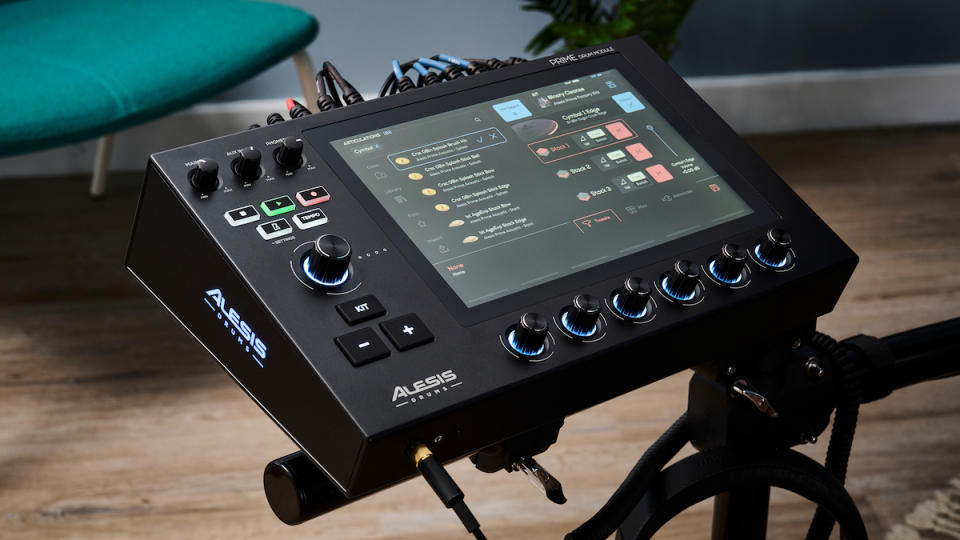
3. Mo’ module
To get anywhere close to recreating the nuanced sound of an acoustic drum kit, you need samples. Lots and lots of them. This isn’t really the problem though - as we’ve already noted, memory is pretty cheap in 2024 and what’s more, we’re dealing with quick, solid-state hard drives. The difficulty comes in playing these sounds back. The module needs to detect a strike from a pad, determine the zone and velocity, then play-back the appropriate sample from its pool of potentials, along with any other microphone positions you might have selected. And it needs to do this in a few milliseconds to avoid latency, requiring some beefy processing power. Indeed, Roland’s digital-sensing pads such as the PD140-DS snare, VH-14 hi-hats and CY-18DR contain additional pre-processors to help take some of the mathematical load away from the module.
All of this is a challenge, but not impossible. Earlier this year, Alesis dropped a bombshell of a module with the Strata Prime. Here, we get a soundset fuelled by the well-established BFD software, complete with multiple microphone positions and multi-layered samples. The Strata Prime isn’t the first to do it - Pearl’s MIMIC is loaded with sounds from Steven Slate Drums, however, Alesis’ take on the concept delivers a fully self-contained kit to go with it.
DWe kits take a slightly different approach, doing away with a module altogether in favour of DW’s Soundworks computer software. Here, the number crunching is taken care of by your computer. However, this does mean that you’re tied to a laptop or desktop, which isn’t a problem for larger touring bands, but could still pose a problem for those of us gigging in grassroots venues such as pubs and clubs.
We think there’s a good chance that modules are going to be increasingly better equipped to deal with intense processing. If brands are intent on taking a computer-based route, we wouldn’t be surprised to see tablet, or possibly even smartphone-based sound generation, given that these devices can now work with external peripherals such as audio interfaces.
4. AI, AI… oh!
Ok, so we’ve all heard about Artificial Intelligence stealing our jobs and faking our identities, with the ultimate goal of wiping out humanity as we know it. But, before that happens we think that AI could prove incredibly useful when it comes to electronic drums.
First up is configuring our kits for us. Electronic drums feature a huge number of variable parameters, and if they’re set incorrectly then our e-kits won’t respond as best as they can. What if we were able to play the kit for a while, and allow the ‘brain’ to figure out our striking style, automatically adjusting velocity curves and volume levels to suit?
Next up is sound generation. We’ve all spent time tweaking the available sounds within our module in order to get them closer to a recording or sound in our head. Generative AI software such as Sony’s DrumGAN, Google’s MusicFX and more can already create sounds from thin air (or rather, learning from millions of samples), and we’d love to see this sort of feature eventually trickle into our e-kits - simply tell the module the sort of sound you’re looking for, or better still, play it a reference and have it generate it for you in seconds!
A big feature on nearly every electronic kit is the ability to jam, whether that’s with the built-in ‘songs’ which tend to vary from a bit cheesy to a downright fondue selection, or (probably more commonly), playing along to your favourite songs. However, AI-powered software such as MOISES has emerged in recent years, and it has the witchcraft ability to deconstruct a stereo recording, allowing us to mute the parts we don’t want and ‘sit-in’ with our favourite bands. We’d love to see this integrated into our drum modules, making learning and practising a whole lot more enjoyable. AI might lead to a dystopian future, but that doesn’t mean there won’t be groove along the way.
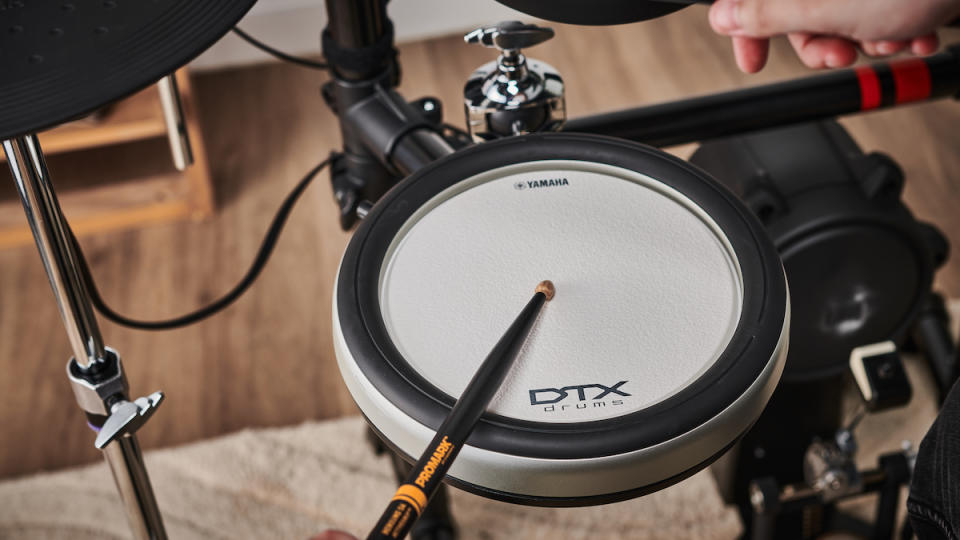
5. RE: Surface
Roland’s introduction of mesh heads nearly 30 years ago is one of the biggest game-changers we’ve seen. Finally, a quiet, tensionable playing surface that responds in a very similar way to an acoustic drum head. But all mesh heads are not created equal, and while we’d argue that for snare and tom pads a mesh head is the best option, it isn’t isn’t infallible and still has its detractors.
Yamaha’s silicone-based playing surface, TCS, has found many-a-fan, but comes without the ability to change the tension. We wouldn’t be surprised to see a Mesh 2.0 at some point, perhaps with a more acoustic-feeling surface that diminishes the tennis racket-like bounce that can still be experienced.
In the words mis-attributed to Henry Ford, “If I’d asked the people what they wanted, they’d have said ‘a faster horse’”, and this definitely applies to our understanding of polymers, chemistry and its application to creating a drumhead. But, we don’t think the pursuit of more realistic playing surfaces will end with a development first made in the ’90s.
6. Easily Triggered
Hit your acoustic drum anywhere across the circumference of its head and you’ll achieve different tonalities. However, multi-position (edge vs centre) sensing is a relatively new development in electronic drums. Snare drums are perhaps the most dynamic shell in our arsenal, and electronic snares are usually equipped with head and rim triggers. Additional detection for head pressure means that we can play the centre of the drum, the rim, a rimshot or a cross-stick. Similarly, our electronic toms are often limited to two zones (head and rim), offering us centre/rim and (sometimes) rimshot sounds.
But we can see a future where electronic drums become much more dynamically versatile. To do this requires more zones, and while Roland’s PD-140DS does a great job of offering some fluid transitions between all of the above articulations, as well as edge-centre positioning, and DW’s DWe snare drum includes an electronic throw-off, there’s still more potential.
Evans has partnered with Sensory Percussion to bring its mind-blowing technology to a wider audience, and one of the standout features of the Sensory Percussion ecosystem is its ability to map up to 10 individual zones across a single drum. It does this via a magnetic, side-mounted sensor and some clever software to interpret the strike position on the drum.
However, Sensory Percussion’s system is less about replicating acoustic drums, and more about transforming the playing surfaces into a complete melodic, electronic musical instrument.
Many of the features we just described - edge-to-centre timbre shifts, bass drum beater-burying, snares on/off, pitch changes via pressure on our toms - exist already, but the ‘standard’ configuration of single and dual-zone response is still most common, particularly at the lower end of the market. We think we’ll see more zones and greater articulation become more ubiquitous in the decade to come, bringing our acoustic and electronic kits even closer together.
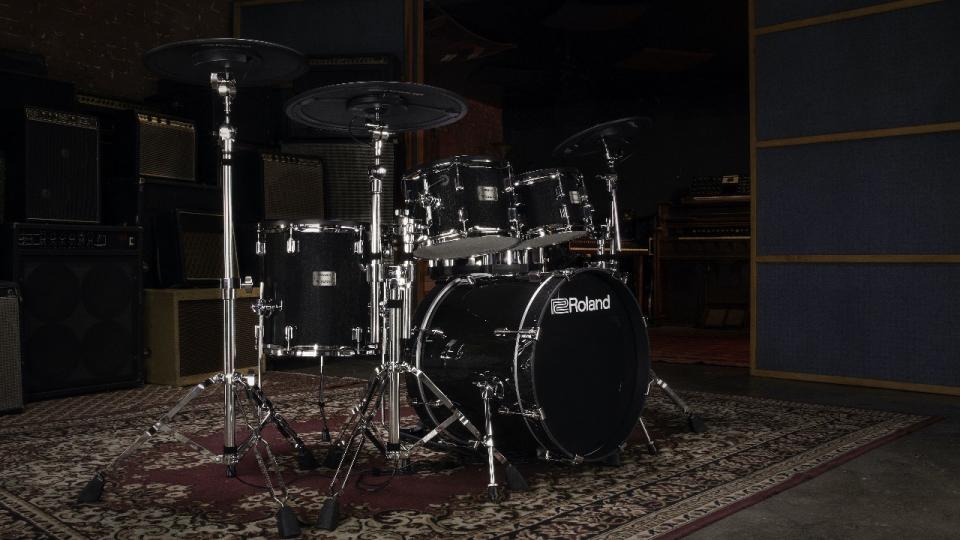
7. Highway to Shell
Take a look at the electronic drum market, and you’ll notice that brands are leaning heavily towards ‘real shells’ as well as drum pads. As well as offering the familiar diameter of an acoustic drum, an electronically-equipped drum shell also adds authentic depth. What does this mean for the sound of the kit? Not a jot. But, it plays a hugely important role in making us feel like we’re sat at a drum kit, because we are!
The dimensions of ‘real shell’ electronic drum sets governs the placement of each kit part’, and unlike our small, shallow pads, small-diameter cymbals and separate bass drum tower, it forces the kit to be set up very similarly to an acoustic setup. The spacing between each drum is more authentic, which in turn affects how we sit, our reach and thanks to the sizing, even the way the cymbal pads respond, and it’s something that every drummer who transitions regularly between acoustic and electronic setups should experience.
Current ‘real shell’ kits such as Roland’s VAD 504/507 series tend to be based on ‘fusion’ kit sizes - that is, a 20” bass drum, 10”, 12” and 14” toms. We think that the future holds more size options, allowing us to fully replicate our acoustic setups with identical sizes.
It’s a similar story when it comes to cymbals too, with Roland, Alesis, EFnote and more continuing to boost the diameter of our cymbal pads, and the latter offers inverted China-shaped pads, hole-laden FX-style cymbals, and identically-sized, 360-degree playable splash cymbals to help enhance the feeling of replicating an acoustic setup. We’ve all laughed at the idea of having a digital cowbell, or perhaps even questioned why we’d need a set of digital octobans, but the truth is, these all add-up to a more realistic playing experience. Of course, part of the benefit of drum pads is the space-saving nature of having a smaller kit. We don’t think we’ll see an end to compact drum pads, rather, a future where we get the option to choose between either, or both.
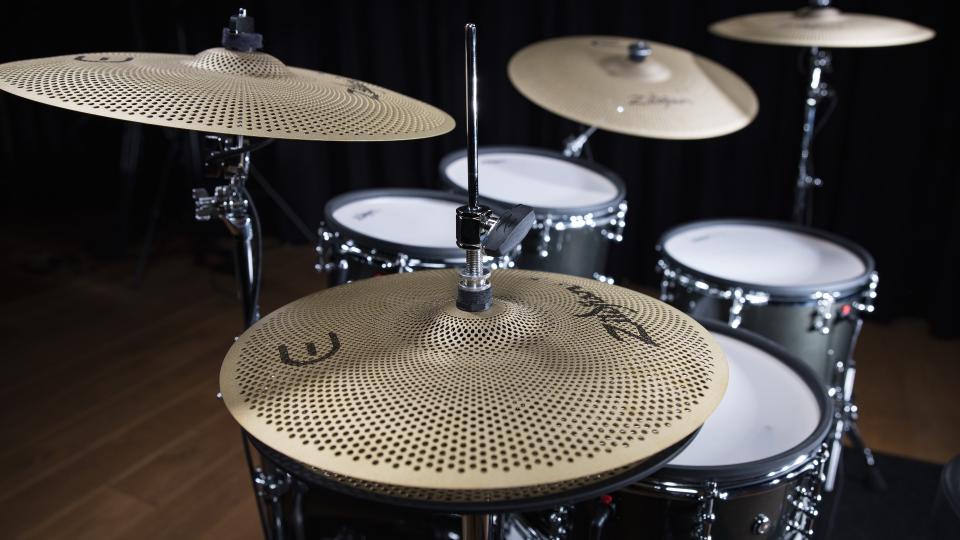
8. Cymbal Plan
So far, our predictions and wishlist has focused largely on the drum ‘pads’ and module. But to many drummers, the stumbling block to a full electronic switchover sits firmly with the cymbals. We’re used to potentially complex, harmonically-rich sounds from our prized metal, and while we’re at a point of very good electronic cymbals, replicating this fully is still a challenge that lies in two areas: physical response and sound characteristics.
Unlike our drums, which are mostly short, staccato sounds, every cymbal hit interacts with the previous. There’s attack, sustain and a polyphonic build-up of wash to contend with.
This once again relies on sampling, and the subsequent processing involved in playing these more intelligent samples back.
Next up is the feel of our cymbals. Not only are they not made of rubber, they’re considerably thinner, weighted differently and move more freely than electronic cymbals. We’ve already mentioned Roland’s digitally-connected VH-14D and CY-18DR hi-hats and ride, which do respond fantastically, but are tied to Roland’s proprietary connection and are currently only compatible with the TD-27 and TD-50/50X modules. Further down the line, Roland is pushing things forward with its latest generation of thinner ‘T’ model cymbals which definitely take some of the resistance out of crashing. Likewise, EFnote and, most recently Alesis with its ARC cymbals are following suit to help make electronic cymbals feel more like the real thing.
However, possibly the most interesting development in the electronic cymbal market is due to come from Zildjian. As with DW, Zildjian has opted for metal cymbals for its forthcoming Alchem-E kits, but unlike the DWe cymbals, it’s taken the ‘practice cymbal’ concept it pioneered with the Gen16 and L80 series, and applied it to electronic cymbals that can be assigned to any sound you desire within the module.
But with metal cymbals comes the enemy of the home drummer: stick noise. We’re not entirely sure exactly how manufacturers can be expected to make a metal cymbal which feels acoustic, with all the benefits of a less intrusive rubber pad. However, we’ve played enough perforated practice cymbals to know that they have a significant effect on volume, while maintaining a natural feel. Let’s face it, if anyone can do it, we’d hope it would be the world’s leading cymbal brand.
9. Closed Shop
For years, it’s been possible to take a pad from here and plug it into a module from there, plug it in with a jack cable and the biggest problem you’re likely to face is a polarity issue. Sorry to spoil the utopian dream of everyone getting along and sharing knowledge for the wider benefit of everyone - this may not be what we’d like to face-up to, but we think proprietary technology is likely to become more prolific.
Why? Well, it’s already happening. If you want to use Roland’s digital pads, you’ll be needing a Roland module. Bought a DWe kit? The wireless connectivity means that if you want to hook up cymbals without resorting to third-party trigger-MIDI workarounds, you’ll need to buy the DWe cymbal pack. Likewise, Zildjian’s forthcoming Alchem-E cymbals use a bespoke connector that, while possible for third-parties to reproduce, is going to take time, and make business sense. All of which assumes that patents and intellectual property rights even make it permissible. So, we think (at least in the immediate future), it’ll be a case of picking your side carefully and sticking with it, just as we do with our phones and computers. That is, until the robots take over.

 Yahoo News
Yahoo News 
